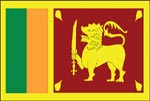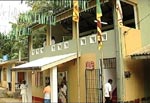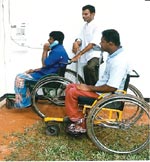Universal access/service
A hands-on experience
 Pushpa Réne Amarasiri Pushpa Réne Amarasiri
Active collaborator on ITU-D Study Group Question 7-1/1 on
Universal access/service. Ms Amarasiri is also the Director of Legal Affairs and
Acting Director of Economic Affairs in the Telecommunicaitons Regulatory Commission of Sri Lanka
ITU 030112 |
|
The ITU
Telecommunication Development Study Groups (ITU-D SG) are carrying out a
study on “Universal access/service” for the benefit of developing
countries, particularly least developed countries. This article draws on
a country report that has been contributed to the study. |
Changing environment
 With the winds of change sweeping across the telecommunication
landscape in Sri Lanka, telecommunication service options will no longer be with
the business community and the privileged few alone. A telephone has ceased to
be a luxury in this small tropical island in the Indian Ocean, off the southern
tip of the Indian Peninsular — separated from India by a narrow strip of shallow
water, the Palk Strait. With the winds of change sweeping across the telecommunication
landscape in Sri Lanka, telecommunication service options will no longer be with
the business community and the privileged few alone. A telephone has ceased to
be a luxury in this small tropical island in the Indian Ocean, off the southern
tip of the Indian Peninsular — separated from India by a narrow strip of shallow
water, the Palk Strait.
Universal access in the early days of the telegraph
The spread of telecommunications in Sri Lanka dates back to 1858
when the first telegraph circuit was commissioned in Colombo and was linked to
Galle in the Southern Province and Kandy in the Central Province, with a
subsequent extension to South India. In the early 1940s, the Telecommunications
Engineering Branch of the Department of Posts and Telecommunications installed
and maintained, free-of-charge, 949 radio receivers on a pilot project for
education, cultural, religious and entertainment purposes. These receivers were
installed at community centres, village committee offices, schools, subpost
offices, temples and churches and worked on batteries. During festivities in the
outback area, radiotelegraph links were established in the rural subpost offices
to send and receive telegrams using the Morse code.
In recent years
Telecommunication policies have been changing constantly in the
past few years, opening up the market to competition. These changes can be
described as “not too fast not too soon”. With the growth in fixed and mobile
telephone services, people were given options to select operators of their
choice. Statistics from the Central Bank of Sri Lanka show that the teledensity
has been increasing steadily since 1998, with record highs in 2001 and 2002 (see
Figure 1). And Internet and e-mail services are expanding rapidly. The opening
up of the market attracted foreign investment in both fixed and cellular
services.
There must be clear policies in place, and it is for the
regulators to apply unambiguous rules, ensuring a return on investment for
companies, by maximizing opportunities for competition and preventing
anti-competitive practices — specially by the dominant operators. Sri Lanka is
now in the process of drawing up rules to prevent anti-competitive practices, in
consultation with the industry and other relevant organizations.
Payphones
A study revealed that 70 per cent of the fixed access telephones
were located in the country’s Western Province and of which 60 per cent were
in the Colombo metro area. As a result, the rural and remote communities
remained unserved. There were inaccessible areas as well in the North and East
of Sri Lanka. As an answer to communication needs, off the beaten track, the
Commission made a public policy recommendation to the Minister of Posts and
Telecommunications in 1998. The payphone subsidy of USD 515 was offered for each
incremental payphone installed outside municipal and urban areas. Recently, the
subsidy was increased to USD 773 per incremental payphone. These payphones will
provide unlimited access for all; 24 hours-a-day.
There was a decline in the payphone operations in 2001 and 2002
(see Figure 2), notwithstanding the subsidy offered to the service providers.
Two of the re-sellers of payphone services are not providing these services at
present.
Rural telecentres
The demand for telecommunication services in the rural areas is
mainly for communication and exchange of information. The telecentres were
accepted with much enthusiasm by the rural folk. These provided the much-needed
telecommunication facilities for rural schools, temples, healthcare centres,
farmers and villagers. Most of these telecentres were accessible to people
living in higher terrains and those who are subjected to unpredictable weather
conditions.
Communication facilities for 590 rural subpost offices
The original plan was to provide telecommunication facilities to
110 rural subpost offices such as telephones and facsimile. On the directive of
the Minister of Mass Communication, the target was increased to provide service
to 590 subpost offices in different districts of Sri Lanka. Service providers
could provide services using alternate technological solutions such as
point-to-multipoint by radio, VSATs (very small aperture terminals) and DECT
(digitally enhanced cordless telecommunications ) — a cordless phone directed
towards a base station of any operator or by wireline.
In most of these rural areas, there is no electricity; but power
can be supplied from solar panels. Frequencies will be on AMPS (advanced mobile
phone system 800-900 MHz).
Telecommunication facilities for people with special needs
The importance of a telephone for persons with disabilities
should be more widely recognized.
Although the architects who drew up the licences incorporated
many important social obligations, such conditions lay dormant for many years.
 Rural folk have accepted telecentres with enthusiasm Rural folk have accepted telecentres with enthusiasm
ITU 030110 |
Protection of Rights of Persons with Disabilities Act No. 28 of
1996 gives the legislative basis for such provisions. In the real sense, it is
important for us to find out whether their needs and aspirations have been
fulfilled. The project commenced in the latter part of 2001 to encourage the
fixed-access operators to provide services to people with special needs and the
elderly.
It was agreed by payphone service providers that special
attention should be given to the dimension of wheelchairs available locally when
constructing payphone booths. There must be sufficient ground space for a
forward or parallel approach by a wheelchair user and the highest part of the
telephone to be within the easy reach of a wheelchair user.
 One project commenced in 2001 to encourage fixed-access
operators to provide services to people with special needs and the elderly One project commenced in 2001 to encourage fixed-access
operators to provide services to people with special needs and the elderly
ITU 030111 |
Recognizing the importance of basic telephone facilities,
particularly for people who never go out due to some form of disability and
those who go out with assistance on rare occasions, it was considered necessary
by all service providers to make available telephone facilities at concessional
rates. The Department of Social Services will help us to identify such people.
Already, telecommunication facilities are provided to Ranaviru
villages. Those that have access to these facilities include “Homes for
children with disabilities”, “Vocational Training Centres for young children
with disabilities”, and “Homes for elders”. All the country’s three
fixed-access operators have now commenced a process to issue Braille bills. For
the first time in Sri Lanka, assistive technologies will be used to provide
telecommunication services for the hearing-impaired citizens. Payphones are
installed within easy reach of wheelchair users, mainly in airports and shopping
centres. Telephone directories, in future, will carry a special supplement and
the international symbol for the disabled will be exhibited where
telecommunication facilities are available for such people.
As the Ranaviru Villages and Centres for People with
disabilities are located in rural areas, the people living in the vicinity could
benefit from the availability of payphones and other communication facilities.
Rural information technology kiosks
The first Rural Information Technology Kiosk was opened recently
to enable people in the rural areas to gain fast access to the Internet and to
the latest telecommunication services. It is also proposed that these kiosks be
run by people with disabilities. The use of the Internet and e-mail per 1000
persons in Sri Lanka is 3.7 per cent, according to year 2002 statistics.
ADSL broadband access
Sri Lanka Telecom commenced the first phase of its roll-out plan
providing innovative broadband access technologies, such as the asymmetrical
digital subscriber line (ADSL) for residential and business users in the
country. This is a great advantage to Internet users as the services would be
available always, without the need to log on and with unlimited access.
The Government’s e-Sri Lanka Programme
“e-Sri Lanka, Smart People, Smart Island Programme” became a
reality with the passing of the ICT Bill in Parliament recently. The
establishment of the Information and Communication Agency (ICT Agency) is
essential, as information technology is the key to developing the country and
linking it globally. The Government is certain that the ICT Agency would help to
uplift the living standards of our people.
Quality of service rules
Sri Lanka’s Telecommunication Act No. 25 of 1991 (as amended)
states that the Commission should take such regulatory measures (including the
issue of directives) as may be necessary to monitor the quality of service (QoS)
provided by operators. The Commission is also to ensure that services conform to
the standards of QoS specified by rules. It is imperative, therefore, that
connections provided conform to service quality standards. Quality of service is
an essential factor to be considered in the provision of universal
access/services. And proper monitoring of QoS is important to protect consumers
from monopoly power.
In August 2001, Quality of Service Standards Rules were gazetted
in the Telecommunication Act. The rules were made after conducting a consumer
survey in various districts. Information obtained from operators are monitored
constantly by the Commission, and such information is published on a quarterly
basis for the consumers’ benefit (see Figure 3). It was expected that these
QoS indicators would cover the major concerns of consumers with regard to
services provided. According to Claire Milne “a fall in quality of service is
a hidden price increase”. When providing universal access/service, it is
important to monitor the quality of services provided; as people should have
affordable access to good quality services.
Indigenous community
Sri Lanka’s indigenous people are called Veddahs or forest
dwellers. They are considered to be the direct descendents from the island’s
original Neolithic community dating back to 14000 B.C. or earlier.
In the ancient times, the indigenous people had very powerful
chiefs and possessed hoards of gold and gems.
Although the Veddah elders were keen to preserve their ancient
traditions, presently thousands of them have been absorbed into the mainstream
community. In the past, to communicate with others, they beat drums or lit
fires. With the changing lifestyles of the community, most have joined the
teaching profession and some have started to use mobile telephones to
communicate with people outside their territory.
Conclusion
The ultimate goal of the Government of Sri Lanka is to achieve
targets set for universal access/services by concentrating on increasing the
teledensity in the rural and remote areas. The intention of the Government is to
develop technology-neutral policies for the future. Telecommunication services,
at present, are also available to indigenous people (cellular mobile services),
people with disabilities and the elderly. Policies will be designed to encourage
local competition, giving consumers a better deal.
|


